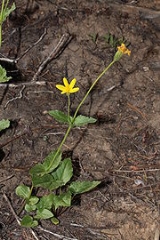
Arnica latifolia
Encyclopedia
Arnica latifolia is a species of arnica
known by the common names Broadleaf Arnica, Broad Leaved Arnica, Mountain Arnica, and Daffodil Leopardbane. It is native to western North America from Alaska
to New Mexico
, where it grows in mountain habitat such as forest and meadows.
This is a perennial herb growing from a long rhizome
and producing a hairy, mostly naked stem 10 to 50 centimeters tall. It has a cluster of leaves around its base and usually a few pairs along the lower part of the stem. The leaves are lance-shaped to broad and nearly heart-shaped, and are usually toothed.
The inflorescence
contains one or more daisylike flower heads lined in glandular phyllaries
. Each has a center of yellow disc florets and several yellow ray florets up to 3 centimeters long. The fruit is an achene
with a white pappus
.
Arnica
Arnica is a genus with about 30 perennial, herbaceous species, belonging to the sunflower family . The genus name Arnica may be derived from the Greek arna, "lamb", in reference to the soft, hairy leaves....
known by the common names Broadleaf Arnica, Broad Leaved Arnica, Mountain Arnica, and Daffodil Leopardbane. It is native to western North America from Alaska
Alaska
Alaska is the largest state in the United States by area. It is situated in the northwest extremity of the North American continent, with Canada to the east, the Arctic Ocean to the north, and the Pacific Ocean to the west and south, with Russia further west across the Bering Strait...
to New Mexico
New Mexico
New Mexico is a state located in the southwest and western regions of the United States. New Mexico is also usually considered one of the Mountain States. With a population density of 16 per square mile, New Mexico is the sixth-most sparsely inhabited U.S...
, where it grows in mountain habitat such as forest and meadows.
This is a perennial herb growing from a long rhizome
Rhizome
In botany and dendrology, a rhizome is a characteristically horizontal stem of a plant that is usually found underground, often sending out roots and shoots from its nodes...
and producing a hairy, mostly naked stem 10 to 50 centimeters tall. It has a cluster of leaves around its base and usually a few pairs along the lower part of the stem. The leaves are lance-shaped to broad and nearly heart-shaped, and are usually toothed.
The inflorescence
Inflorescence
An inflorescence is a group or cluster of flowers arranged on a stem that is composed of a main branch or a complicated arrangement of branches. Strictly, it is the part of the shoot of seed plants where flowers are formed and which is accordingly modified...
contains one or more daisylike flower heads lined in glandular phyllaries
Bract
In botany, a bract is a modified or specialized leaf, especially one associated with a reproductive structure such as a flower, inflorescence axis, or cone scale. Bracts are often different from foliage leaves. They may be smaller, larger, or of a different color, shape, or texture...
. Each has a center of yellow disc florets and several yellow ray florets up to 3 centimeters long. The fruit is an achene
Achene
An achene is a type of simple dry fruit produced by many species of flowering plants. Achenes are monocarpellate and indehiscent...
with a white pappus
Pappus (flower structure)
The pappus is the modified calyx, the part of an individual disk, ray or ligule floret surrounding the base of the corolla, in flower heads of the plant family Asteraceae. The pappus may be composed of bristles , awns, scales, or may be absent. In some species, the pappus is too small to see...
.

